
Felipe Baeza presents "Sentir un entonces y un allí" at Kurimanzutto gallery through July 19. Between the redistribution of the possible, the affective, and the atemporal, Zayd González writes about the exhibition.
Purple rain, purple rain
I only want to see you,
only want to see you
in the purple rain.
—Prince
I become a beetle that weaves its black honey,
I become a woman like any minority.
I am involved in its matrix of outrage,
I make alliances with the Indo-Latin mother and
"I learn the patriarchal language to curse it."
—Pedro Lemebel
The exhibition Sentir un entonces y un alli [Feeling a then and there] by the artist Felipe Baeza, originally from Celaya and based in New York, is being presented at the Kurimanzutto gallery. The main nave welcomes us with walls painted in shades of purple, echoing the color palette used by the artist for the pieces in the exhibition: twenty two-dimensional pieces and a glass sculpture. The use of color evokes the convention popularized since World War II that blue is for boys and pink is for girls… but what about purple? According to an imaginary formula—the result of collapsing blue and pink—: for children. In this speculative logic, purple does not designate neutrality, but rather a potentiality not tamed by binarity.
The title of the exhibition, as well as the conceptual driving force behind the pieces, come from the book Cruising Utopia: The Then and There of Queer Futurity by Cuban-American critic Jose Esteban Muñoz. He proposes the use of utopia, hope, and imagination to bring new realities to light, beyond the limitations of a hetero- and homonormative present, all through a performative, sensorial, and active aesthetic.
The bodies illustrated in Felipe's pieces flow and transform into colors and organic shapes that sometimes fuse human, animal, and plant parts; "bodies suspended, in flight, with no fixed identity or defined belonging." The precision and care in the production are particularly notable: the two-dimensional works are made from an accumulation of paper upon paper, cut, pasted, embroidered, pigmented, corroded, and frayed by hand. These are materials that the artist selects from a vast personal archive collected over time.
Through the infinite layers of paper, obsessively and carefully manipulated by Baeza, a rupture is almost hinted at, an opening toward something more. It's the exuberance of the craft: the power to make extraordinary things emerge from something as mundane as paper, ink, thread, a box cutter, and glue.
At the center of the exhibition are eleven portraits of figures that, from the artist's perspective, embody some form of transgression: Octavia, Marsha, Sylvia R., Audre, Belkis, among others. The portraits are veiled and obscured by layers of color and texture. Isis Yepes, in an essay on the exhibition, explains that the tactic of hiding faces responds to “a stance that resists established forms of representation […]. Baeza's portraits do not aim to fix the images or monumentalize them in order to read them again from the continuum of hetero-linear history. On the contrary, opacity is chosen to deny a system that attempts to protect totality, exclusion, and established labels.”
It is curious that the proposal for resistance to the invisibility imposed on certain bodies and certain lives is precisely opacity, and not the aesthetic and conceptual potential that their illumination can offer to the spectator. There is power in denial when it is fertile, when it proposes something more, when it invites us to look elsewhere, even inward. A denial that functions as “a modality of the possible, a regression to infinity.” The abstract shapes, the colors, and the eyes isolated from the face—the only visible traces in the portraits—should be an invitation to disarm one’s gaze, to let the hidden reveal its density to us without demanding immediate visibility. However, they risk hiding more than they reveal, diluting the promise of that then and there.
One of the strengths of this body of work is the dialogue it creates between characters who don't share the same time or territory, but who have something in common. A table where living and dead diners coexist. And I'm not just referring to the rebellious figures hidden in the portraits, but also to the connection the artist proposes with those who visit the exhibition: "It is in this sense that the field of art represents and expands the notion of society, because it includes not only the living but also the dead and even those who have not yet been born."
In recent years, Mexico City's art scene has given rise to exhibitions and curatorial devices that embody similar maneuvers regarding the intersection of time and space, even expanding them to the point of breaking down disciplines and conventions. I want to elaborate on this idea with three examples:
Redistribution of the possible: Arbol de zapatos [Shoe Tree] (2024) is a piece by Samuel Nicolle included in the group exhibition Fe y alegria [Faith and Joy] that subverts the dynamics of a gallery by using his sculpture as a support to exhibit the work of nine other artists who were not officially invited. The artist hacks an individual invitation to turn it into a collective tactic. The privileged space unfolds to accommodate others.
Emotional outpouring: Curiosito [Curious little one] was a group exhibition that brought together the work of thirteen people who do not define themselves as artists per se, but who by chance ended up producing artistic objects. It was a collection of gestures that sought to broaden the spectrum of what is considered a queer sensibility.
Timeless fag chorality: Una habitacion impropia [An Improper Room] (2023) was a series of performative readings, the result of a collaboration between the writer Tonatiuh Lopez and myself, in which the voices of nine notable fags (Oscar Wilde, Salvador Novo, Javier Villaurrutia, Carlos Pellicer, Andy Warhol, Reinaldo Arenas, Johan Mijaíl, among others) were brought into dialogue to answer the question: Who owns a room where, no matter how many attempts, that love that dares not even speak its name is constantly being executed? This happened as a set of repeated interventions in the exhibition Donde nace la frivolidad: Objetos de mi afeccion [Where Frivolity is Born: Objects of my Affection], by artist Samuel Nicolle.
These dissident situations and devices reflect the aesthetic and political power of queens and fags: methods for transcending the obvious, opening dialogue, and considering the possibilities that art offers us.
Jose Esteban Muñoz, in his Utopia Queer, uses an early theoretical corpus of Heidegger, a philosopher highly controversial for his later affiliation with Nazism, but in whose initial proposals he identifies a failed power that deserves to be rethought. “While I, too, have great disdain for what Heidegger's writing became, I nonetheless regard it as a failure worth acknowledging, a potential that failed, but can nevertheless be reworked in the service of a policy and an understanding of different worlds.” Finding light where you least expect it is a gesture of brilliance. Perhaps it's up to us, too, to examine our references more deeply, to activate them in risky and unexpected ways, through performance, participation, and collective action, or through irony, abjection, tenderness, or ritual; to avoid obvious assumptions that, through overuse, become new norms.
By challenging Baeza's exhibition with other forms of creation, exhibition, and mediation, I attempt to highlight what the strategies of production and circulation of knowledge that emerge from the margins allow us to shed light on in the field of art. Beyond its market effectiveness, an exhibition should be able to be measured by its ability to generate resonance: aesthetic, ethical, emotional, and political. Let us remember that: “Art was produced before the emergence of capitalism and the art market, and when these disappear, art shall continue.” And that “art is art to the extent that it is something more than art”: that it is a sphere both separate from politics and, nevertheless, always political, because it contains the promise of a better world. Otherwise, we run the risk of the lines of flight becoming ordinary commercial routes that are simply useful: for the market, for the galleries, for the symbolic correction of the system.
If the transgression embodied by fagginess and the margin becomes simply a crystallized subjectivation and all its power is limited to adapting to a style, a repeated identity, or an imported theoretical artifice, then queerness ceases to be a rupture and becomes a formula. It is an exhausted horizon: alien, sterile. At times, Baeza's exhibition seems to border on that formula; at others, it even goes beyond it. What is needed is to reappropriate the theory. Actually, beyond that, we develop other, different ones, born from our urgencies, our bodies, and our stories. Not as a reflection, but as a situated gesture. “A corporeal militancy that emphasizes, from the edge of the voice, a unique and fragmented discourse.” Since “queerness is always on the horizon”, in that case we have to take ownership of that horizon. Because if we don't make it our own, we'll only be left with the flashes of others—and that's not enough.
Let us learn the master's tongue to curse it, like Caliban. If the tactic of institutions and galleries is to aestheticize and co-opt our differences to serve the market, what is our true agency in all this? Perhaps imagining different ways of relating to the master, that give us back the means of production and our ability to imagine and manage our own desire. Reclaiming our horizons to reveal new ones. Creating more habitable worlds for ourselves: the creative working class. But we also need to ask ourselves if it's possible to subvert this inherited and archaic binary dynamic of master and slave and, instead, propose new forms of connection and alliances between us: more perverse, more intelligent, more horizontal, more affective. Transitioning from Hegel to Masoch, from power games to contracts. Questioning ourselves, honestly, where our loyalties lie: In sexuality, in friendship, in class, in art? To what extent are we also those who, by repeating certain attitudes, reinforce the master we want to deny? Let us position ourselves gently, but clearly.
Only in this way can we feel a real then and there: political, aesthetic, vital and affective. A gesture of one's own, born of desire and becoming. Perhaps one that does not need a master or a slave to exist.

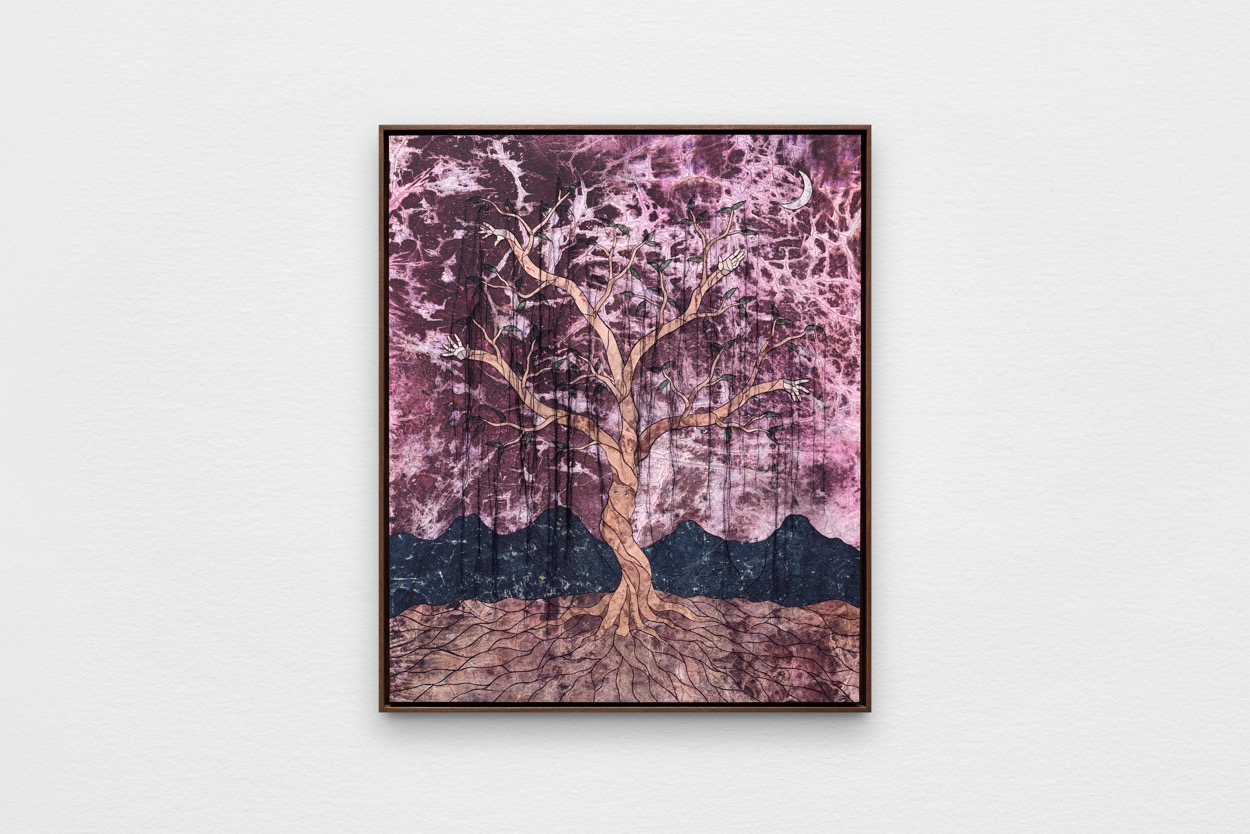
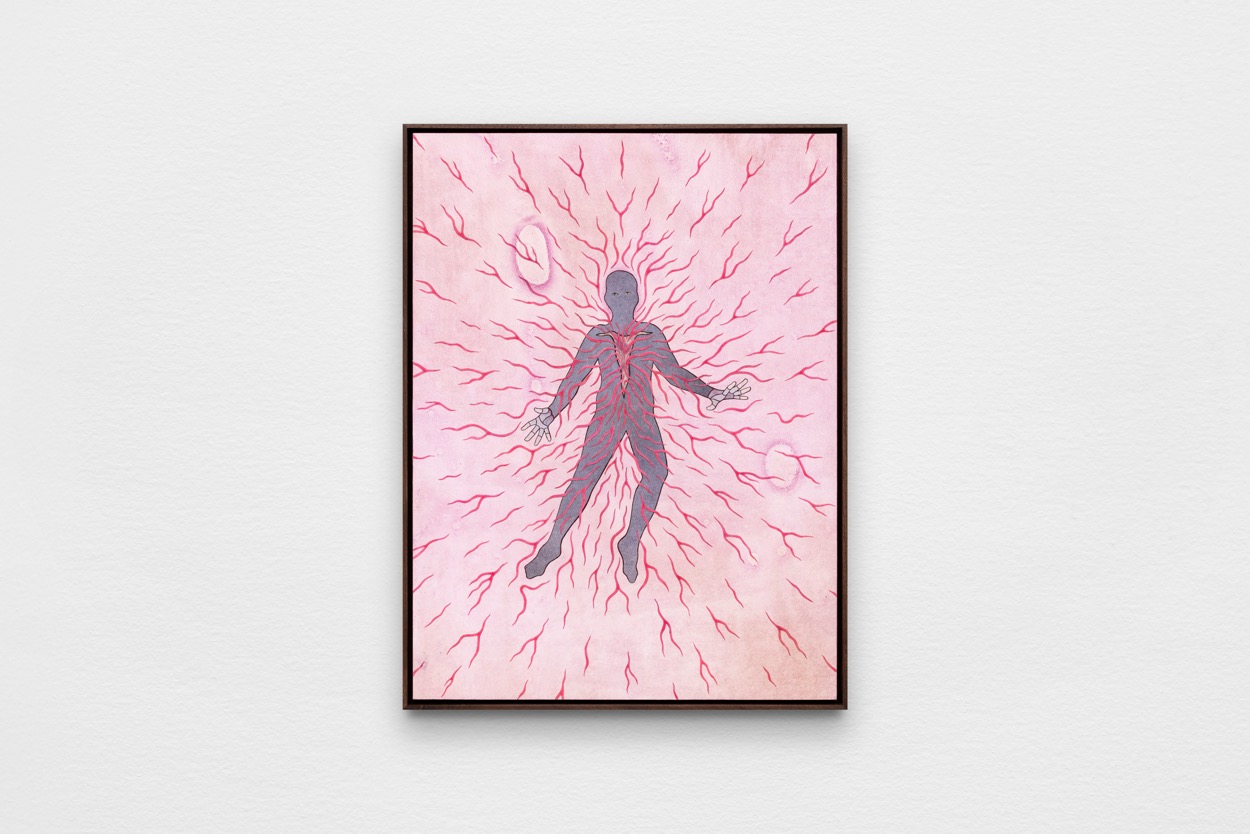
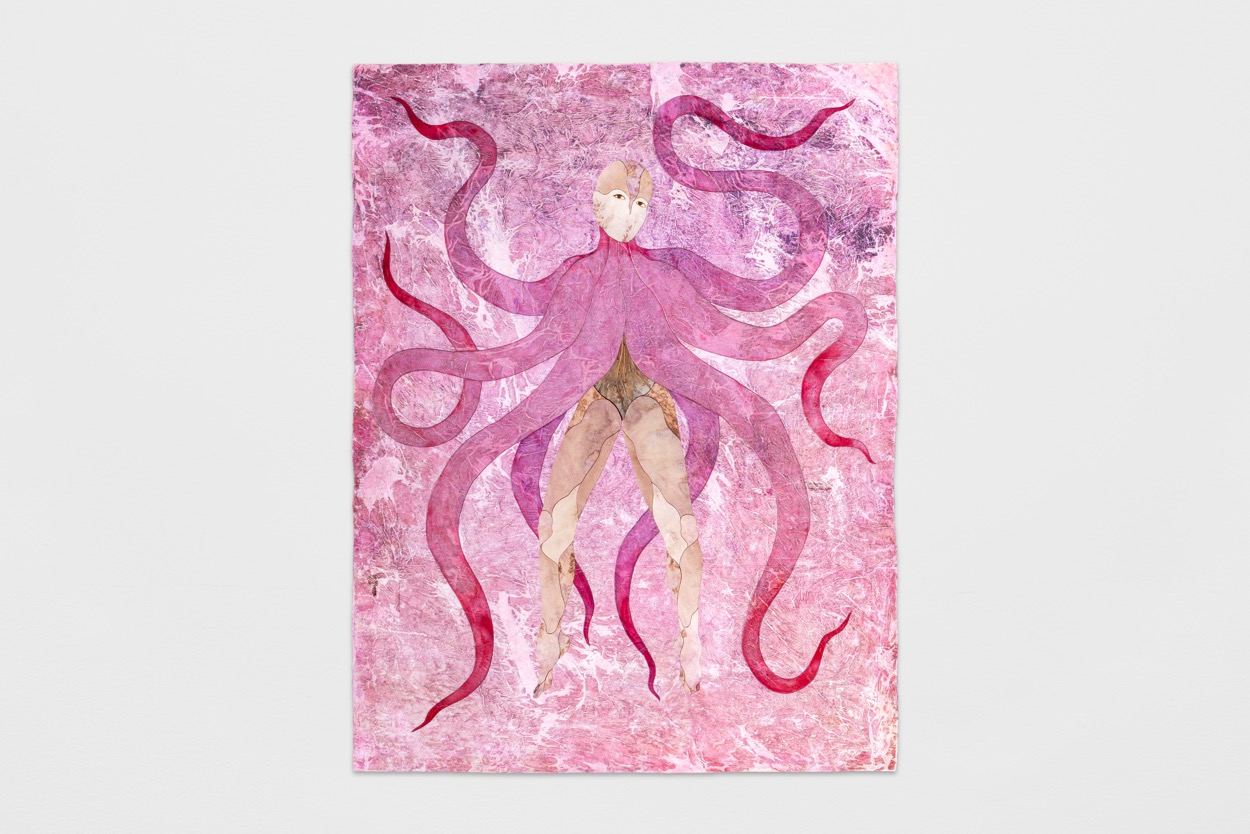
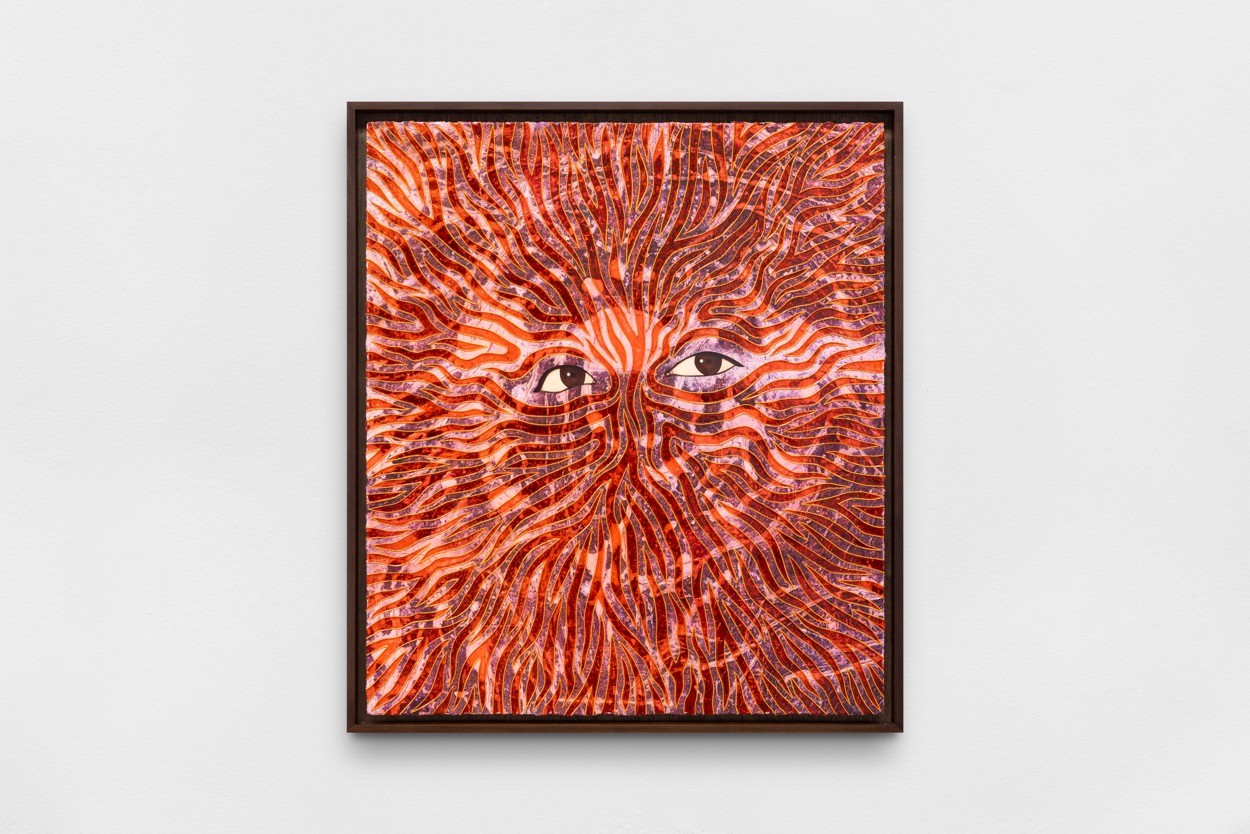
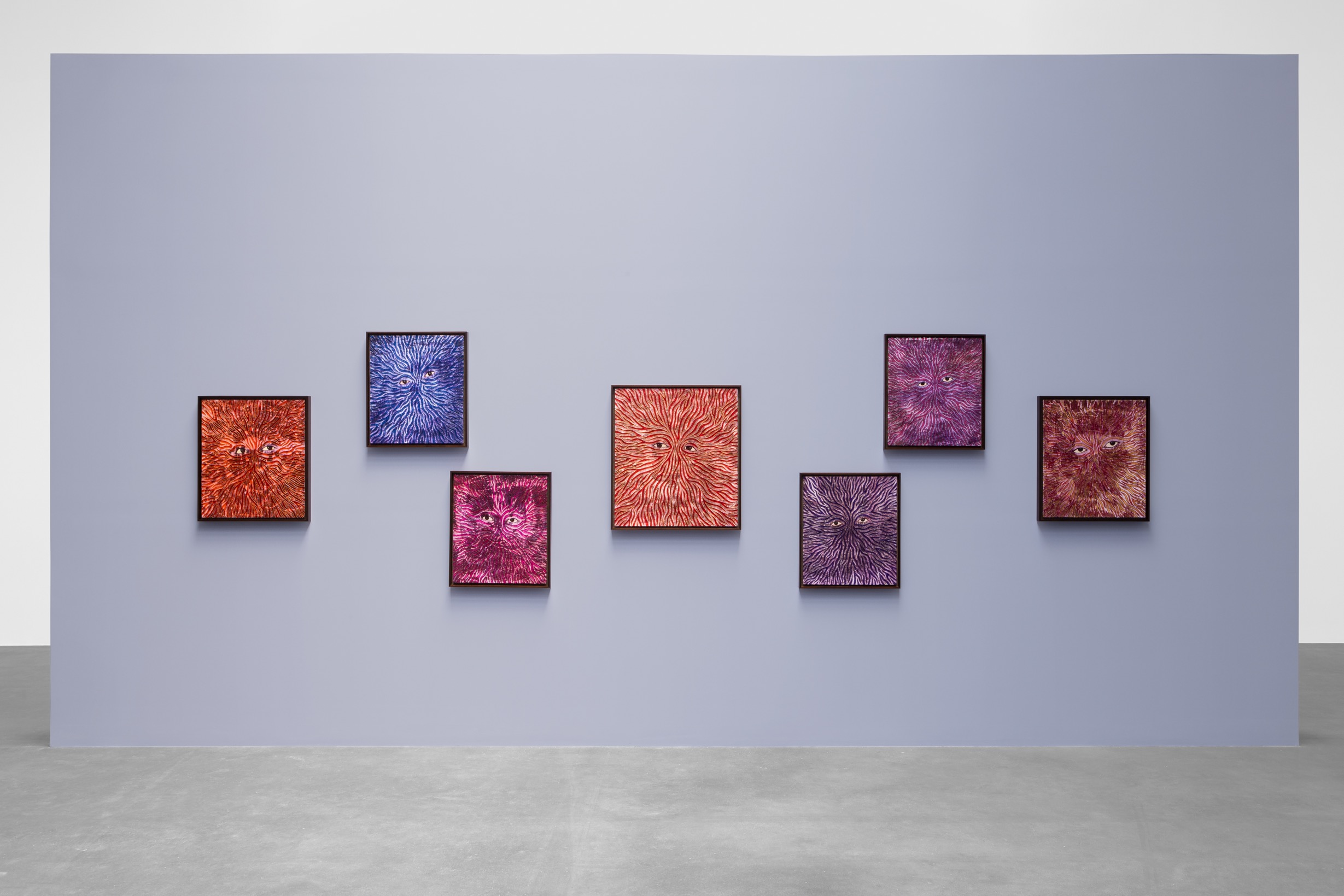
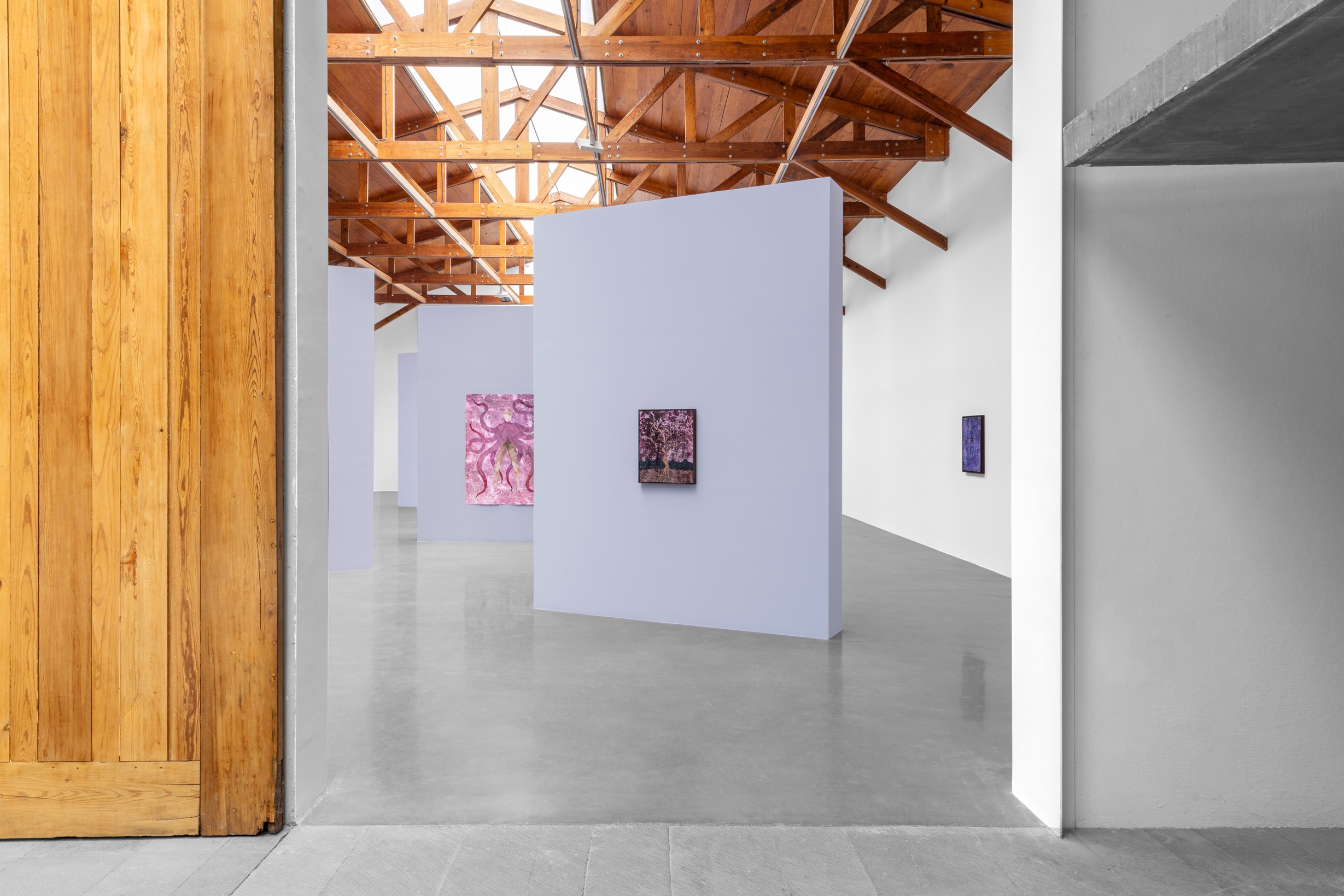
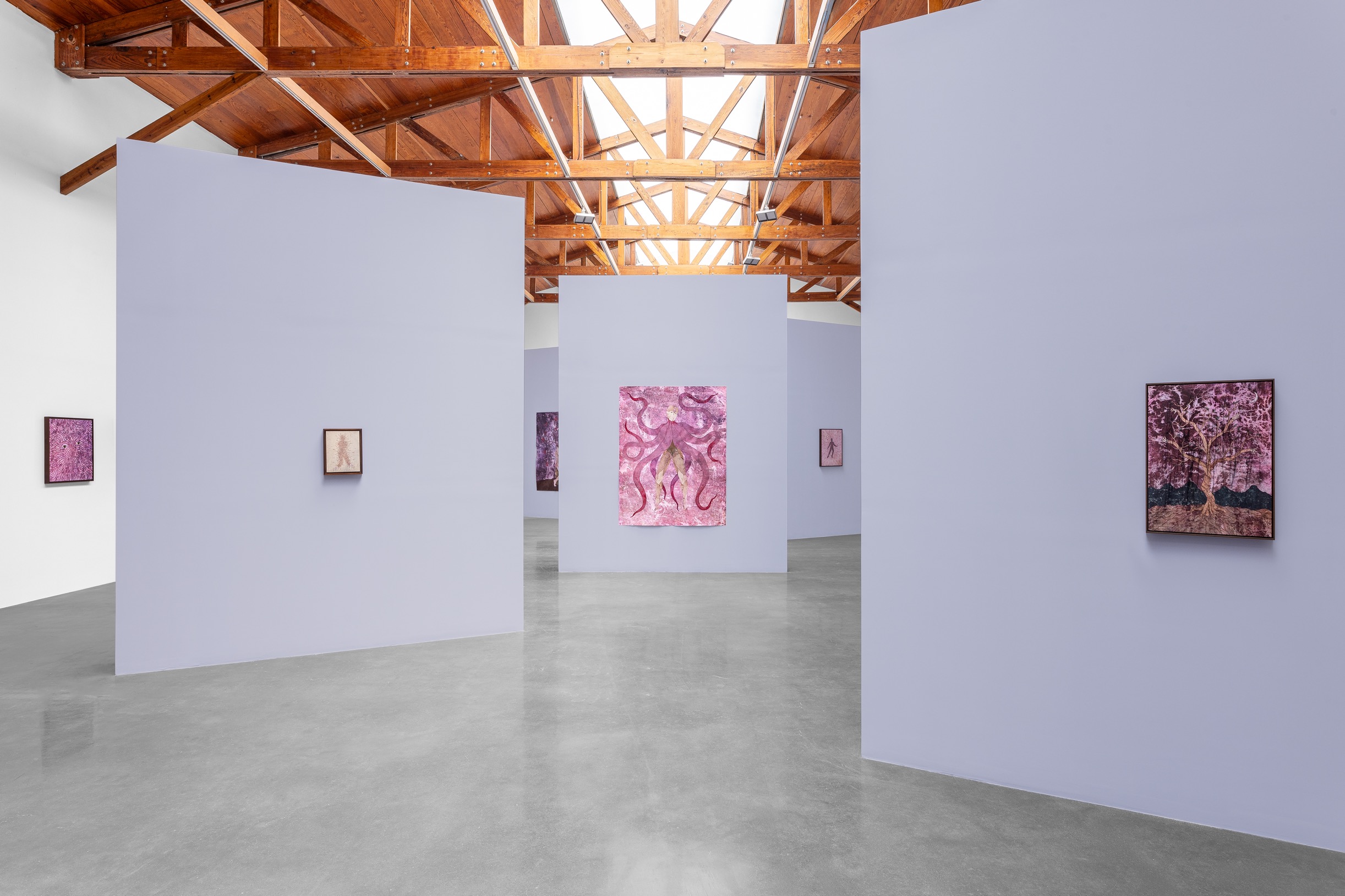

Purple rain, purple rain
I only want to see you,
only want to see you
in the purple rain.
—Prince
I become a beetle that weaves its black honey,
I become a woman like any minority.
I am involved in its matrix of outrage,
I make alliances with the Indo-Latin mother and
"I learn the patriarchal language to curse it."
—Pedro Lemebel
The exhibition Sentir un entonces y un alli [Feeling a then and there] by the artist Felipe Baeza, originally from Celaya and based in New York, is being presented at the Kurimanzutto gallery. The main nave welcomes us with walls painted in shades of purple, echoing the color palette used by the artist for the pieces in the exhibition: twenty two-dimensional pieces and a glass sculpture. The use of color evokes the convention popularized since World War II that blue is for boys and pink is for girls… but what about purple? According to an imaginary formula—the result of collapsing blue and pink—: for children. In this speculative logic, purple does not designate neutrality, but rather a potentiality not tamed by binarity.
The title of the exhibition, as well as the conceptual driving force behind the pieces, come from the book Cruising Utopia: The Then and There of Queer Futurity by Cuban-American critic Jose Esteban Muñoz. He proposes the use of utopia, hope, and imagination to bring new realities to light, beyond the limitations of a hetero- and homonormative present, all through a performative, sensorial, and active aesthetic.
The bodies illustrated in Felipe's pieces flow and transform into colors and organic shapes that sometimes fuse human, animal, and plant parts; "bodies suspended, in flight, with no fixed identity or defined belonging." The precision and care in the production are particularly notable: the two-dimensional works are made from an accumulation of paper upon paper, cut, pasted, embroidered, pigmented, corroded, and frayed by hand. These are materials that the artist selects from a vast personal archive collected over time.
Through the infinite layers of paper, obsessively and carefully manipulated by Baeza, a rupture is almost hinted at, an opening toward something more. It's the exuberance of the craft: the power to make extraordinary things emerge from something as mundane as paper, ink, thread, a box cutter, and glue.
At the center of the exhibition are eleven portraits of figures that, from the artist's perspective, embody some form of transgression: Octavia, Marsha, Sylvia R., Audre, Belkis, among others. The portraits are veiled and obscured by layers of color and texture. Isis Yepes, in an essay on the exhibition, explains that the tactic of hiding faces responds to “a stance that resists established forms of representation […]. Baeza's portraits do not aim to fix the images or monumentalize them in order to read them again from the continuum of hetero-linear history. On the contrary, opacity is chosen to deny a system that attempts to protect totality, exclusion, and established labels.”
It is curious that the proposal for resistance to the invisibility imposed on certain bodies and certain lives is precisely opacity, and not the aesthetic and conceptual potential that their illumination can offer to the spectator. There is power in denial when it is fertile, when it proposes something more, when it invites us to look elsewhere, even inward. A denial that functions as “a modality of the possible, a regression to infinity.” The abstract shapes, the colors, and the eyes isolated from the face—the only visible traces in the portraits—should be an invitation to disarm one’s gaze, to let the hidden reveal its density to us without demanding immediate visibility. However, they risk hiding more than they reveal, diluting the promise of that then and there.
One of the strengths of this body of work is the dialogue it creates between characters who don't share the same time or territory, but who have something in common. A table where living and dead diners coexist. And I'm not just referring to the rebellious figures hidden in the portraits, but also to the connection the artist proposes with those who visit the exhibition: "It is in this sense that the field of art represents and expands the notion of society, because it includes not only the living but also the dead and even those who have not yet been born."
In recent years, Mexico City's art scene has given rise to exhibitions and curatorial devices that embody similar maneuvers regarding the intersection of time and space, even expanding them to the point of breaking down disciplines and conventions. I want to elaborate on this idea with three examples:
Redistribution of the possible: Arbol de zapatos [Shoe Tree] (2024) is a piece by Samuel Nicolle included in the group exhibition Fe y alegria [Faith and Joy] that subverts the dynamics of a gallery by using his sculpture as a support to exhibit the work of nine other artists who were not officially invited. The artist hacks an individual invitation to turn it into a collective tactic. The privileged space unfolds to accommodate others.
Emotional outpouring: Curiosito [Curious little one] was a group exhibition that brought together the work of thirteen people who do not define themselves as artists per se, but who by chance ended up producing artistic objects. It was a collection of gestures that sought to broaden the spectrum of what is considered a queer sensibility.
Timeless fag chorality: Una habitacion impropia [An Improper Room] (2023) was a series of performative readings, the result of a collaboration between the writer Tonatiuh Lopez and myself, in which the voices of nine notable fags (Oscar Wilde, Salvador Novo, Javier Villaurrutia, Carlos Pellicer, Andy Warhol, Reinaldo Arenas, Johan Mijaíl, among others) were brought into dialogue to answer the question: Who owns a room where, no matter how many attempts, that love that dares not even speak its name is constantly being executed? This happened as a set of repeated interventions in the exhibition Donde nace la frivolidad: Objetos de mi afeccion [Where Frivolity is Born: Objects of my Affection], by artist Samuel Nicolle.
These dissident situations and devices reflect the aesthetic and political power of queens and fags: methods for transcending the obvious, opening dialogue, and considering the possibilities that art offers us.
Jose Esteban Muñoz, in his Utopia Queer, uses an early theoretical corpus of Heidegger, a philosopher highly controversial for his later affiliation with Nazism, but in whose initial proposals he identifies a failed power that deserves to be rethought. “While I, too, have great disdain for what Heidegger's writing became, I nonetheless regard it as a failure worth acknowledging, a potential that failed, but can nevertheless be reworked in the service of a policy and an understanding of different worlds.” Finding light where you least expect it is a gesture of brilliance. Perhaps it's up to us, too, to examine our references more deeply, to activate them in risky and unexpected ways, through performance, participation, and collective action, or through irony, abjection, tenderness, or ritual; to avoid obvious assumptions that, through overuse, become new norms.
By challenging Baeza's exhibition with other forms of creation, exhibition, and mediation, I attempt to highlight what the strategies of production and circulation of knowledge that emerge from the margins allow us to shed light on in the field of art. Beyond its market effectiveness, an exhibition should be able to be measured by its ability to generate resonance: aesthetic, ethical, emotional, and political. Let us remember that: “Art was produced before the emergence of capitalism and the art market, and when these disappear, art shall continue.” And that “art is art to the extent that it is something more than art”: that it is a sphere both separate from politics and, nevertheless, always political, because it contains the promise of a better world. Otherwise, we run the risk of the lines of flight becoming ordinary commercial routes that are simply useful: for the market, for the galleries, for the symbolic correction of the system.
If the transgression embodied by fagginess and the margin becomes simply a crystallized subjectivation and all its power is limited to adapting to a style, a repeated identity, or an imported theoretical artifice, then queerness ceases to be a rupture and becomes a formula. It is an exhausted horizon: alien, sterile. At times, Baeza's exhibition seems to border on that formula; at others, it even goes beyond it. What is needed is to reappropriate the theory. Actually, beyond that, we develop other, different ones, born from our urgencies, our bodies, and our stories. Not as a reflection, but as a situated gesture. “A corporeal militancy that emphasizes, from the edge of the voice, a unique and fragmented discourse.” Since “queerness is always on the horizon”, in that case we have to take ownership of that horizon. Because if we don't make it our own, we'll only be left with the flashes of others—and that's not enough.
Let us learn the master's tongue to curse it, like Caliban. If the tactic of institutions and galleries is to aestheticize and co-opt our differences to serve the market, what is our true agency in all this? Perhaps imagining different ways of relating to the master, that give us back the means of production and our ability to imagine and manage our own desire. Reclaiming our horizons to reveal new ones. Creating more habitable worlds for ourselves: the creative working class. But we also need to ask ourselves if it's possible to subvert this inherited and archaic binary dynamic of master and slave and, instead, propose new forms of connection and alliances between us: more perverse, more intelligent, more horizontal, more affective. Transitioning from Hegel to Masoch, from power games to contracts. Questioning ourselves, honestly, where our loyalties lie: In sexuality, in friendship, in class, in art? To what extent are we also those who, by repeating certain attitudes, reinforce the master we want to deny? Let us position ourselves gently, but clearly.
Only in this way can we feel a real then and there: political, aesthetic, vital and affective. A gesture of one's own, born of desire and becoming. Perhaps one that does not need a master or a slave to exist.









